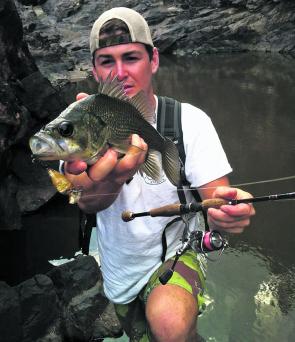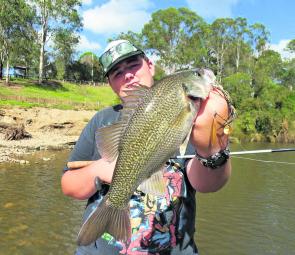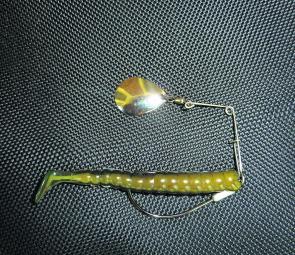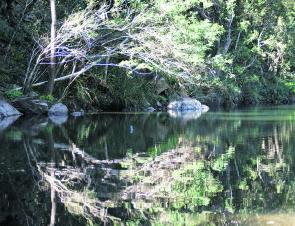Queenslanders are almost spoilt when it comes to freshwater fishing options, but when the cicadas start ringing, most freshwater fishers know it’s time to fish for bass!
For those wishing to avoid the crowds, new to bass fishing or who simply can’t afford a boat or kayak, you should try fishing small streams from the bank. While many bass are caught in stocked impoundments and in our larger rivers in boats and kayaks, there is also sensational bass water that is beyond the reach of any vessel. These small creeks or upper sections of rivers can only be fished on foot.
These waterways may be small, but some very big bass can be extracted from pools you can almost step over! This kind of fishing is accessible, great fun and can also be extremely rewarding.
The difficulty of this task depends on where you live, but as a general rule, any freshwater stream from the Burnett River in Bundaberg to Wilson’s Promontory in Victoria is worth a look. By using maps on the Internet and even topographical maps you should be able to close in on a likely looking stream.
Then comes a bit of research. The stream will need to have some water all year round and must have access to the saltwater, because bass use the salt to breed during the cooler months. You should also check to see if there are any weirs, culverts or low bridges that may impede fish migration, but don’t be surprised if bass have found a way around these obstacles; they are amazingly agile little fish.
There’s only so much the Internet and maps will do for you, so getting out and looking at the stream for yourself beats any form of theory when sussing out likely bass habitat.
I have a few tests I like to do when checking to see if the creek is bass-able. Firstly, I stick my arm in the water up to my elbow and if I can still see my fingers in the water, it’s definitely clear enough to use lures. Secondly, I like to walk along the bank to see if there’s any pools where I can’t see the bottom. These will be your main fish holding areas. The presence of mullet, eels, turtles and eel-tail catfish in these pools are also very good signs. Thirdly, select out likely fish holding structure within these pools in the form of logs, large rocks, under cut banks and thick vegetation, which bass can hide under. If your creek has all these things and your casting arm is twitching, it’s time to get your gear together!
In terms of clothing, you will want something that won’t cause you to overheat, but enough to provide you with some protection from the shrubs, spikey vines and other things we love about the bush.
You should have enclosed shoes that will give you protection; I usually opt for light hiking style boots but sand shoes will do just fine.
A backpack or bum bag that you can carry your lures, spare leader material, hook removing pliers, a snake bite kit and water is a must for any one wanting to bush bash. I usually carry my phone and camera in a dry bag that fits into my main bag in case I decide to wade or make any unexpected plunges into the drink! All of these things should be easy to carry and shouldn’t weigh you down, because you might have to walk some distance!
Your outfit is a personal thing, but for those new to bass fishing, here are a few guidelines to get you rolling. A rod weight ranging from 1-5kg is perfect, with shorter rods proving to be less trouble when fishing under thick foliage. A length of 5-6’ is perfect, but this can vary due to your height, the creek you fish and the rods you have available. As a general rule, you want something that’s tippy enough to throw a longer cast, but powerful enough to handle angry bass, because small water bass often need a bit more than gentle persuasion to pull out!
A threadline or spinning reel is much more suited to this small water fishing and anything between a 1000-3000 size range will do the trick, so long as it feels comfortable on your rod.
As for line, I like to use braid for castability. Anything from 4-10lb will do for your mainline, and between 8-12lb for your leader. For those who don’t use braid, straight low-stretch monofilament between 8-12lb will handle any bass swimming.
While this is again a personal choice, certain lure types really shine in this tight country. You should keep your presentations small.
My first choice is surface lures, because bass in small waterways are very switched on and are often feeding on insects and a surface lure will fall into the pool like an insect falling out of a tree. Some great surface lures to try are the 5cm Rebel Pop R, Heddon Tiny Torpedo and Teeny Torpedo, Predatek Spaddler in both 40 and 50mm, Sammy 65, Kokoda Bat and any other insect imitating surface lure that will fit in the palm of your hand.
Subsurface presentations are good for when the sun is right up, or when you come to a pool that is a bit deeper. Spinnerbaits and beetle spin type lures are good for deeper water, although they are snag magnets! A snagless beetle spin can be made from a plastic grub, a weighted weedless hook and a spinner arm to curb this problem, and they are deadly on bass!
Diving plugs such as the Manns 5+, Atomic Hardz Crank 38, Cotton Cordell Big O and the Rebel Deep R are all known bass catchers.
Buoyancy is the key to keeping your lures from snagging and letting them float up a few inches when you feel them hit a snag will save you some bucks. Rigging your crankbaits up with W style hooks also prevents the loss of lures or impromptu swimming.
If soft plastics are your thing, then there’s plenty of plastics that work well on creek dwelling bass. Anything that fits in the palm of your hand rigged with lightweight and preferably a weedless hook is dynamite for covering the depths of the pools. Squidgy, Atomic, Z-Man, Zerek and Gulp all make small soft plastics that lend themselves to this sort of fishing.
Something known to most bass fishers is that bass bite the best at either end of the day when the sun is low. In small water though, time of day matters less, especially if there is ample shade and there is no one other than you fishing for them.
Fishing these tiny waterways requires a certain level of stealth; crashing through the bush and casting your shadow over the pool won’t catch you many bass. There’s two ways to approach small stream fishing. Either you can walk along the bank and find places to poke through and have a few casts, or you can jump in the creek and wade, casting well ahead of yourself at likely looking structure. By using the latter method, you’ll tend to cover more water, however when the water gets too deep you may have to revert back to the bank.
Each pool should be covered thoroughly; remembering that some structure may be in the middle of deep pools, so a few casts into the middle of each pool may pay off. I generally work upstream, so if anything spooks, they will tend to flee downstream and not upstream where you intend to fish.
Something you’ll learn quickly in small stream bass fishing is the importance of working your lure all the way back to your feet! I’ve lost count of the amount of times my lure has been snaffled at my feet in plain sight.
Another misconception about bass is how comfortable they are in shallow water. Even though fishing deeper pools are preferred, a few exploratory casts into shallow pools when you’re on the move can improve your catch rates. A rule to remember with creek bass is they will live in water of any depth, so long as they have something over their head.
When water gets a bit skinny and you think the fish-able limit may have been reached, you should trek further upstream. You’d be surprised at how often deep dark pools are found upstream of insignificant stretches that barely trickle!
Lastly, make sure where you’re fishing is legal. Sometimes fishing below dams, weirs and on private land can get you mixed up with the authorities and ignorance to the law won’t help you. Do some research or ask people about the legality of your chosen location and if your creek passes through private land, ask the owner for permission to fish it; they’ll probably have no issues if you present yourself in a respectable way.
While this fishing can be challenging, it’s important to remember that this is one of the key reasons we like to fish for bass! In a few trips you will start to notice patterns with your chosen water and this will help you to understand it so you can catch more bass and become a better angler.
These techniques can be taken south in search of trout, north for jungle perch and sooty grunter, and around the world for any creek-dwelling predatory fish! This sort of fishing will set you up if you’re new to lure fishing and you will experience some exciting fishing and some awesome serenity without a boat or kayak! So get your-self out of the air-conditioned rooms to where the cicada’s ringing is almost deafening so you can tangle with one of Australia’s premier sportfish.
Reads: 3431
Wading in small creeks can be very rewarding when the bank is too steep. The author took this creek bass on a Heddon Tiny Torpedo from waist deep water!

Iain Thornton works over a snaggy pool with a small diver. Younger anglers really enjoy this highly mobile style of fishing.

Tom Gordon loves fishing skinny creeks for bass and pulled this one out a very rocky pool on a shallow diver.

Fishing small streams for bass is full of surprises. This endangered Mary River cod was taken from a shady pool on a surface lure and was handled with care before it was released.

Larger pools are usually best worked with subsurface lures. Kaspar Lenigas took this better than average creek bass on a 1/4oz spinnerbait in broad daylight.

The author’s homemade snagless beetle spin, made using a Slider grub, a TT spinner arm and a Nitro wide gape weedless worm hook with added weight. This little contraption catches bass and doesn’t snag.

A perfect pool, with deep banks and plenty of shade and bank side structure, this pool has bass written all over it!




